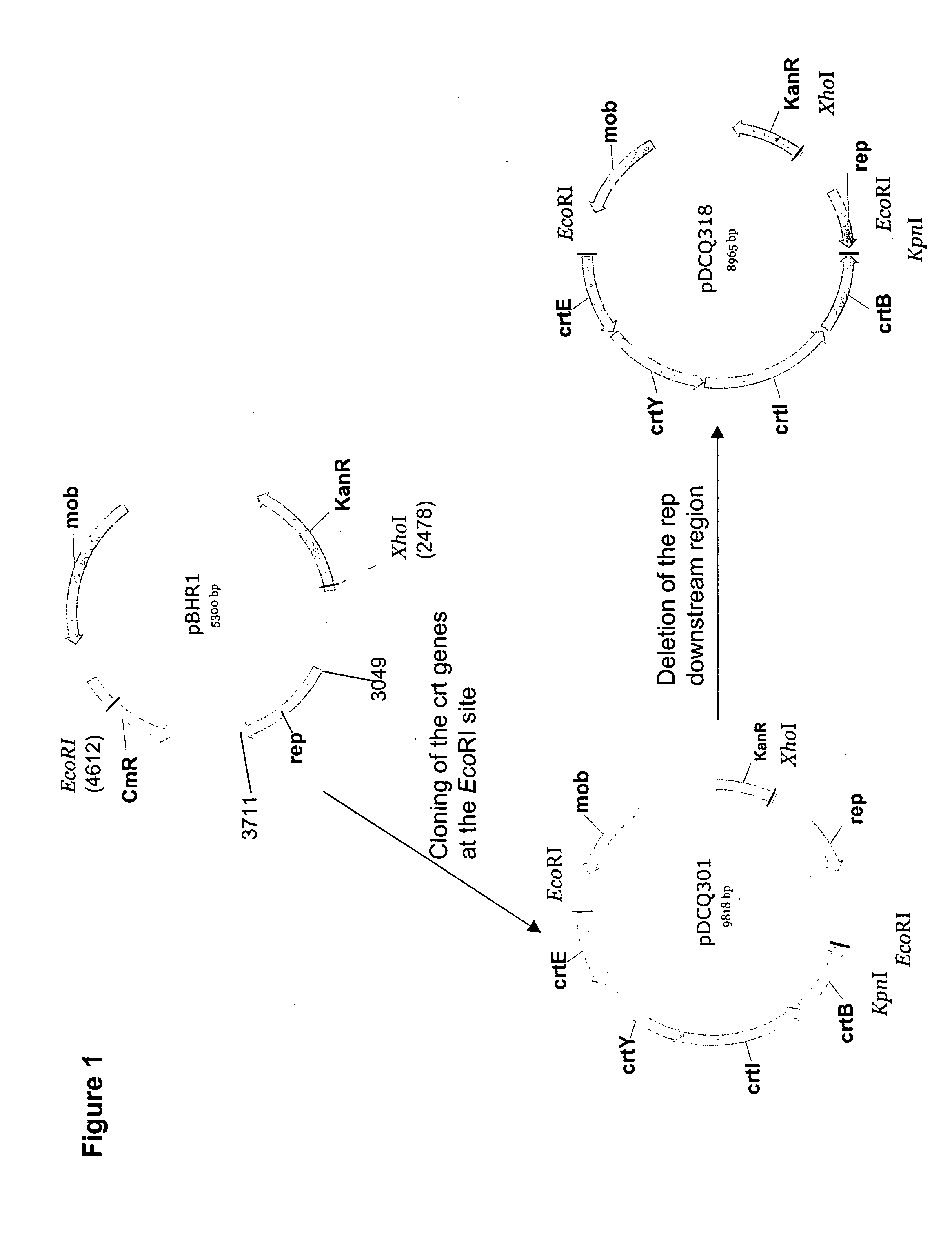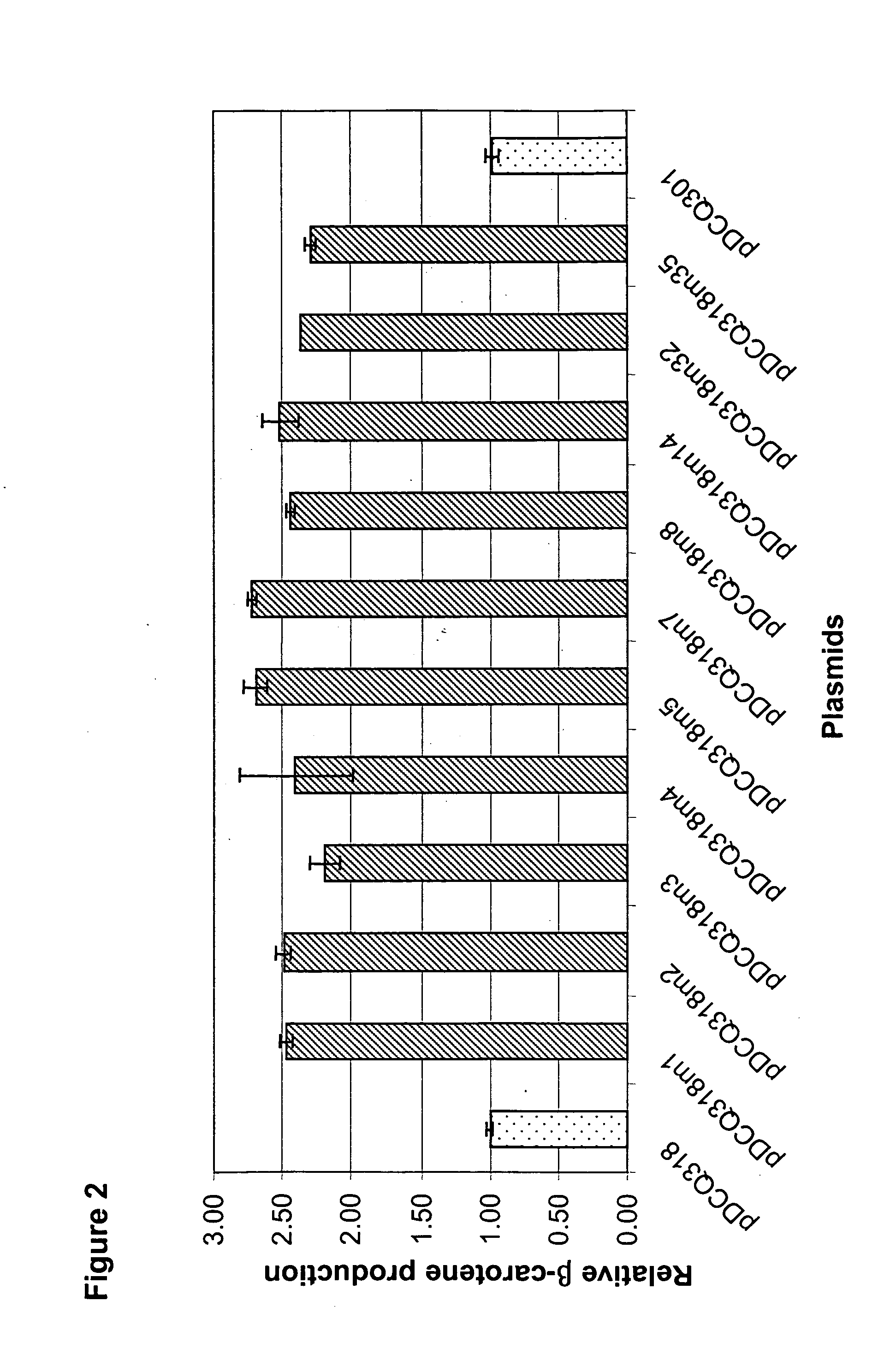Broad host range pBBR1-based plasmid mutant derivatives having altered plasmid copy number
- Summary
- Abstract
- Description
- Claims
- Application Information
AI Technical Summary
Benefits of technology
Problems solved by technology
Method used
Image
Examples
example 1
Construction of pBHR1 Based Reporter Plasmids
[0250] This example describes cloning of a carotenoid synthesis gene cluster for use as a reporter construct and its insertion into the pBHR1 vector backbone. Two plasmids were constructed for this study: pDCQ301 and pDCQ318. pDCQ301 contains a crtEYIB gene cluster cloned into the EcoRI site of the pBHR1 vector. pDCQ318 contains a deletion of the downstream region of the rep gene from pDCQ301.
Amplification of the Pantoea stewartii crtEYIB Gene Cluster
[0251] The carotenoid synthesis genes crtEYIB encode enzymes for synthesis of β-carotene, which was used as a reporter molecule for mutant screening in this application. Pantoea stewartii ATCC #8199 (WO 03 / 016503) contains the natural gene cluster crtEXYIBZ. The genes required for β-carotene synthesis (i.e., crtE and crtYIB) were joined together by PCR. Specifically, the crtE gene and crtYIB genes were each amplified using chromosomal DNA as template and the following primers:
TABLE 2Pri...
example 2
Isolation of Mutant Derivatives of Plasmid PDCQ318 that Show Increased Carotenoid Production
[0257] This example describes how error-prone PCR was used to introduce mutations into the replication control region of plasmid pDCQ318, resulting in increased □-carotene production. Specifically, the replication control region was first amplified by error-prone PCR from pDCQ318. The resulting PCR product was ligated into a restriction fragment derived from pDCQ318, such that the original replication control region of pDCQ318 was replaced with the products of the error-prone PCR reaction. Ten mutant plasmids were identified that resulted in increased carotenoid production in E. coli.
Construction of pDCQ318 Mutant Plasmid Library by Error-Prone PCR
[0258] Error-prone PCR was performed to amplify a 1461 bp fragment from pDCQ318 that contained the native rep gene (corresponding to nucleotides 3049-3711 of pBHR1, provided in SEQ ID NO:1). Each PCR reaction was performed with AmpliTaq DNA poly...
example 3
Sequence of the Replication Control Region in plasmid DDCQ318 and its Mutant Derivatives
[0263] This example describes the sequences of the mutant replication control regions in ten plasmid derivatives of pDCQ318 that over-produced β-carotene. Sequence analysis indicated that the error-prone PCR mutagenesis reactions had resulted in at least one or more mutations in each mutant plasmid, with respect to the rep gene and its flanking sequences in pDCQ318.
Sequencing of Mutant Replication Control Regions
[0264] The ten mutants that showed the highest increase in β-carotene production (i.e., pDCQ318M1, pDCQ318M2, pDCQ318M3, pDCQ318M4, pDCQ318M5, pDCQ318M7, pDCQ318M8, pDCQ318M14, pDCQ318M32, and pDCQ318M35; see FIG. 2) were selected for further characterization. Each mutant was inoculated into 10 mL LB medium in a 150-mL flask with 50 μg / mL kanamycin and cultured at 220 rpm at 37° C. for 17 h. Plasmid DNA was extracted from 1.5 mL cells using a QIAprepe® Spin Miniprep Kit (Qiagen Inc, V...
PUM
| Property | Measurement | Unit |
|---|---|---|
| Temperature | aaaaa | aaaaa |
| Fraction | aaaaa | aaaaa |
| Fraction | aaaaa | aaaaa |
Abstract
Description
Claims
Application Information
 Login to View More
Login to View More - R&D
- Intellectual Property
- Life Sciences
- Materials
- Tech Scout
- Unparalleled Data Quality
- Higher Quality Content
- 60% Fewer Hallucinations
Browse by: Latest US Patents, China's latest patents, Technical Efficacy Thesaurus, Application Domain, Technology Topic, Popular Technical Reports.
© 2025 PatSnap. All rights reserved.Legal|Privacy policy|Modern Slavery Act Transparency Statement|Sitemap|About US| Contact US: help@patsnap.com



